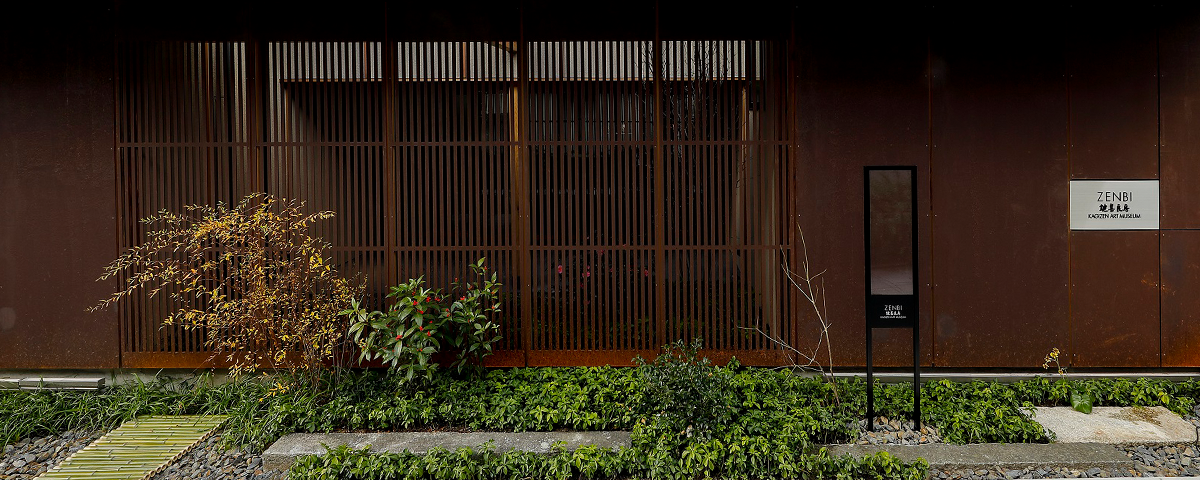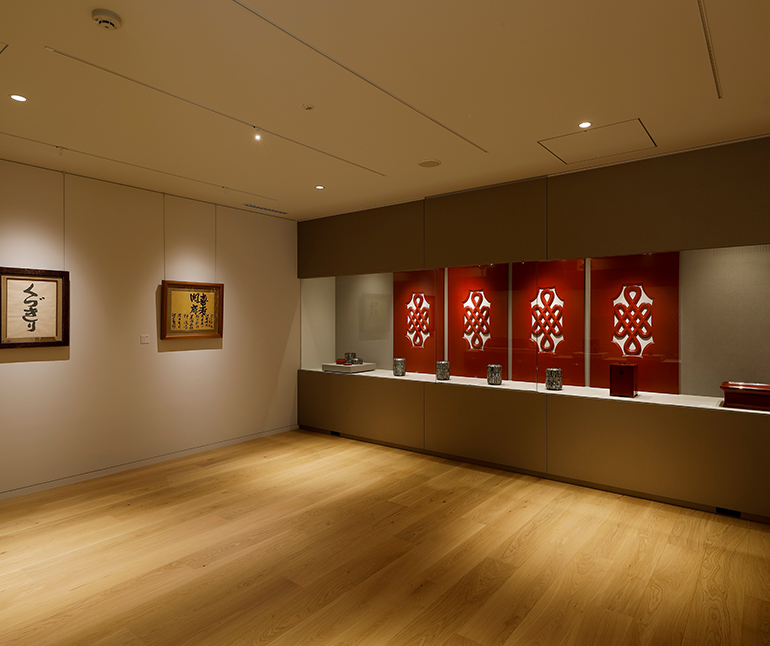
ご挨拶 Message
八坂神社の門前の茶屋街から発展し、南座などの芝居小屋があったことから京都そして日本を代表する花街として名を馳せた祇園町。鍵善良房は江戸中期享保年間に創業以来、この地に集う人々にご愛顧賜り、文人墨客の方々をはじめ舌や目の肥えた皆様に育てて頂いて参りました。このたびこの町の一角にZENBI-鍵善良房-KAGIZEN ART MUSEUMという小さな美術館を設立することになりました。この町から頂戴した高い文化の恩恵を皆様に少しでも知って頂き、この町の文化サロンのような場を継承していければというのがこの美術館の目的です。
昭和初期に鍵善の当主であった今西善造は、様々な文化活動を通じて多くの文化人や芸術家たちと交流を深めました。なかでも同世代の木工作家黒田辰秋と意気投合し、彼の才能に惚れこみ鍵善の店内の改装を任せる計画をしていたと聞いています。善造が夭逝したためにその内容は今ではわかりませんが、二つの大飾棚を始め、くずきりの螺鈿用器などその後黒田辰秋の作品を代表するものが多く残されています。戦後、その思いは彼の妹である鈴木愛子と鍵善の後を継ぐことになった今西晴子の親子によって受け継がれました。黒田辰秋さんを始め河井寬次郎さんら同じ民藝運動の方々、多くの文化人の方、なによりも鍵善を愛してくれたお客様たちによって再開後は店は順調に続いて参りました。 その後先代の今西知夫は、建物を伝統的でありながらモダンなものに改築するにあたり黒田辰秋の朱の結び紋様のウィンドーバックをそのまま使い、大飾棚二つを向かい合わせに置きました。これは善造がもともと思い描いていた飾棚の置き方で、その思いはまた受け継がれ、今でも多くの客様をお迎えしています。
そして当代の私もその思いを受け継ぎ、祇園町南側にゼンカフェという作家の作品に触れ合えてゆっくりできる大人の空間を2012年に作りました。そしてこの向かいに先代が若い芸術家の発表の場として作った「スペース空・鍵屋」を改築して今回の美術館を建てることになりました。美術館では黒田辰秋の作品を中心に優れた美術工芸の世界をご紹介するとともに、京都ならではの文化を発信し、日常の暮らしの中にある美を後世に伝え残す場所となればと思っています。なによりこの町が大事にしてきた美に対する意識をこの町に訪れた皆様にも知って頂き、将来へと伝えていければ幸いです。
ZENBI-鍵善良房-KAGIZEN ART MUSEUM
館長今西善也
ZENBI (Kagizen Art Museum)
Gion grew from the teahouse district (chayagai) close to the gate to Yasaka Shrine, and eventually went on to gain fame as a leading entertainment quarter (hanamachi) in Kyoto, and throughout Japan, thanks to the Minami-za kabuki theater and other theaters in the area. Since its founding during the Kyoho Period (1716-1736), Kagizen Yoshifusa has enjoyed the patronage of the people of the area, and been frequented by writers, artists, and others with discerning tastes. Kagizen is now opening a small art museum called ZENBI (Kagizen Art Museum) in Gion. The aim of the museum is to share in some small way the blessings we have received from the refined culture of Gion and to continue Kagizen’s role as a local focus where people of culture can gather.
In the early Showa Period (1926-1989), Zenzo Imanishi, the head of the Kagizen family business at the time, developed close ties with persons of culture and artists through various cultural activities. He found a kindred spirit in one in particular, the woodworker and lacquerware artist Tatsuaki Kuroda, who was around the same age. Zenzo was enthralled by Kuroda’s work, and I was told that he planned to have Kuroda redesign the interior of Kagizen. Details of these plans are not known today because Zenzo died prematurely, but many items representative of Kuroda’s subsequent work do survive, including two large display cabinets and raden inlay bowls for kuzukiri noodles. After World War II, Zenzo’s appreciation of Kuroda’s work was taken up by his sister, Aiko Suzuki, and her daughter Haruko Imanishi, who took over the Kagizen family business. The store has prospered after its reopening thanks to Tatsuaki Kuroda, Kanjiro Kawai and other members of the Mingei movement, numerous persons of culture, and, most of all, each of the patrons of Kagizen.
Afterwards, when Tomoo Imanishi, my predecessor in charge of Kagizen, renovated the building, giving it a modern, yet still traditional new look, he retained Kuroda’s aka-urushi (vermillion) takaramusubimon motif screen as the background to the display window, and placed the two large display cabinets facing each other. That is the arrangement originally envisioned by Zenzo for the cabinets, and his inspiration continues to greet many customers to this day.
As the current head of Kagizen, I also inherited Zenzo’s sentiments, and, in 2012, I created ZEN CAFE, a quiet, sophisticated space where art can be appreciated in a relaxed setting in Gion-machi Minamigawa. Recently, we decided to rebuild Space Kagiya, the venue created by my predecessor for young artists to exhibit their work on the opposite side of the street, and to turn the new space into an art museum. We want the museum to become a venue for presenting the world of superb kogei craftsmanship, with a particular focus on the works of Tatsuaki Kuroda, as well as for disseminating the distinctive culture of Kyoto and passing down the artistic beauty found in everyday life to future generations. Most of all, we hope it will communicate to visitors to the Gion District the appreciation for beauty that the area has always had, and will pass it on to future generations.
Zenya Imanishi, Director
ZENBI (Kagizen Art Museum)

